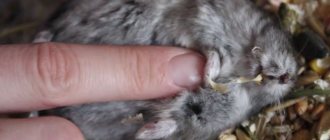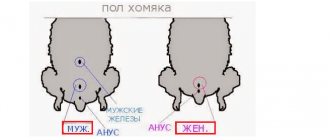03/23/2020 19,482 Hamsters
Author: Olga
If you decide to get a hamster, then you need to be prepared for the fact that a number of difficulties and problems await you, and not just a cute creature. One of these can be considered the fact that the hamster is gnawing on the cage. Absolutely everyone will face this situation, so it is necessary to deal with it immediately and choose an effective solution method. And then in the future you will ensure a happy life not only for yourself, but also for your pet.
[Hide]
Physiological features
In nature, mice, rats and other rodents eat tough, fibrous foods. At the same time, they have to run a lot, and since the roots and plants are poor in calories, they have to look for food almost constantly. Teeth are used every day to loosen the soil and dig up food and chew it. That's why they wear off quickly. Nature has provided for the rhythm of life of these creatures and provided them with upper incisors, which are devoid of anatomical roots. They continue to grow throughout the animal's life. Now let's return to our question of why a hamster chews its cage. We will try to find the answer to this further.
A method on how to detect a fugitive and his secret hiding place.
We will fish with live bait - sunflower seeds (for example, or another favorite delicacy, but it must smell). In each room we put a small pile of seeds, and sprinkle flour or starch around it, and you can also pour paths between the doorways between rooms. In this way, you can use the trail of flour to determine where the hamster ran with the seeds.
Method on how to catch a nimble hamster
The simplest, but least effective way is to place a cage with a slightly open door where there is a treat, so that he would run in there out of habit to pick up a treat or run in a wheel, and you close the door. This approach rarely works, since you will have to monitor the cage all the time; such a trap will only stand in one place. And considering that hamsters are nocturnal animals and can only run out for cover in the dark, the plan is almost doomed to failure.
Much more efficient way. 24/7 trap.
In the middle of the room we place a box of sufficient height so that the hamster cannot get out of it (25-30 cm), we make steps on all 4 sides (for example, from books), we put a sheet of paper on the top of the box, and pour it on top a bunch of seeds. The sheet of paper should not fall under the weight of the bait, but with a hamster it should fall down. You can use thin cardboard.
From the box, in 4 directions, we make bulk paths with seeds, one seed per step and every 5-10 cm one seed.
When the runaway hamster comes out of his hiding place, he will not be able to ignore his favorite treat and will begin to collect seeds on his cheeks, walk up the steps to the box, because there are also seeds there, and as soon as he takes a step towards the hamster’s happiness, he will fall to the bottom of the box , from where he cannot get out on his own.
These traps can be placed in every room and do not need to be constantly monitored. The main thing to keep in mind is that a Syrian hamster will need a deeper box than a Djungarian one.
Home living
Your pet does not have to worry about food, because you constantly fill his feeder with nutritious grains. Often, owners even overfeed their pets. “But how can that be? - you object. “After all, I fill the bowl exactly according to the instructions.” It's not even that he eats a lot. He just has nowhere to waste his energy. He imposingly strolls from the house to the feeder and crunches ready-made grains that do not need to be dug up or chewed off. But you can't argue against nature. Teeth continue to grow at the same rate as their wild counterparts. That's why the hamster chews the cage, it adjusts their length.
How to distinguish a Djungarian hamster from a Campbell's hamster
Both species belong to the genus Hairy Hamsters. Animals can mate with each other, so hybrids are very common in pet stores. They are small in size, they can be from 7 to 10 cm in length. An adult rodent will weigh no more than 60-70 g. Both breeds are nocturnal.
Since both the Djungarian and Campbell's hamsters are small in size, they can be kept in small cages, aquariums or plastic terrariums. They should be kept separately. The bedding must be shavings or sawdust. Most of their menu consists of cereal mixtures, pumpkin seeds and dried corn on the cob.
Therefore, before buying a hamster, you need to study the information about the breed you are interested in in order to purchase it. After all, each type of animal has different needs for care and maintenance.
Color
When purchasing a pet hamster, you first need to pay attention to its coat color. Thanks to this, you can determine its breed
Dzhungarik coat color:
The predominant colors are dark shades of brown, as well as gray and black. In most cases, this breed has a diamond pattern on its head. It can blend in with the main color of the animal or be clearly outlined. For example, if the animal is brown in color, then the diamond will be drawn most clearly. In gray animals it is difficult to notice
It all depends on the main color of the animal. You need to pay attention to the sides of your pet. This breed has well-defined arches between its back and belly. You also need to look at the stripe that is on the back
In the Djungarian breed it has clear boundaries, and in the area of the withers it expands.
Campbell's hamster color:
- Sand and amber shades predominate. There are also black representatives. The color may contain light shades of brown.
- There are also arches on the sides, but they are practically invisible, as they merge with the main color of the coat.
- The dorsal stripe of this breed is much thinner, and in the lower part of the body it can hardly be seen.
- There is a spot on the coat.
- These rodents have a richer variety of colors. Among the representatives of the breed there are albinos, rodents with agouti, argenta, gray and spotted colors.
Campbell's fur is in tatters.
Coat type
The appearance of the coat, which varies among breeds, is also very important. The Djungarian hamster's coat is much denser, very smooth and even.
Campbell's hamster gets it in tatters. Somewhat reminiscent of sheep's wool. When the animal moves, it is divided into stripes.
Body type
Both breeds have almost the same dimensions. Their body length does not exceed 10 cm. Therefore, these breeds are called dwarf.
If you take a good look at their physique, you can see that there are still some differences. Campbell's rodent has a waist. If you look at the animal from above, then its body shape is similar to the number “8”.
The Dzungarian breed does not have a waist. His physique is more rounded. If you look at it from above, its shape can be compared to an egg.
Have you tried to look at the differences between the two types of hamsters? Poll Options are limited because JavaScript is disabled in your browser.
Two species of hamsters have different personalities
Character
They have very different characters. Campbell's hamster is distinguished by its aggressiveness and restive character. Very often bites people when they try to pick him up.
The situation is different with the Djungarian hamster. He is not prone to aggression, so he can rarely bite a person or a child. The owner will not have to spend a lot of time taming it. You only need to show a little care and patience to ensure that your pet is affectionate and delights both adults and children. With the right approach, this animal will even fall asleep in the arms of its owner.
Djungarik is better for children
Rhythm of life
This has been more or less sorted out. But a completely logical question remains. You buy special sharpeners for incisors at the pet store, lay out various twigs, twigs, and put up stumps that seem quite suitable to you. Why does the hamster chew on the cage with the same persistence? The reason is quite simple, the rods are very well secured and therefore comfortable for the pet. You can correct this situation and tie several wooden sticks on the cage machines. Most likely, the hamster will switch to them.
How to prevent escape?
To prevent your pet from escaping again in the future, take a number of simple measures. First of all, check the strength of the hamster’s home: whether the door is securely locked, whether the rods are loose. Always close the cage, even if you are only distracted for a couple of minutes.
Make sure that the animal is comfortable, there are no irritants, and there are enough toys. Make sure the cage is located in a quiet, calm place, away from direct sunlight or drafts.
Clean your hamster's house regularly. While cleaning, place your pet in a deep container or walking ball.
And most importantly, pay more attention to the hamster: play, pick it up more often. Please note that this must be done when the pet is awake, otherwise you will achieve the opposite effect.
Night activity
And everything would be fine if the pet performed all its exercises to destroy iron bars during the day. But most often, owners are interested in another question - why the hamster gnaws at the cage at night. This is a consequence of their biological activity. Its peak occurs right in the middle of the night, when you are supposed to be sound asleep. So it turns out that the furry animal sleeps quietly all day, and as soon as you go to bed, it begins to gnaw furiously on the metal bars. The sounds are simply terrible, they really irritate the owners.
Why does a hamster chew on a cage: possible reasons, what to do
If you have an adorable rodent, don’t be surprised if a characteristic sound wakes you up at night. These are nocturnal creatures that will look for entertainment until dawn, and then go to bed. It’s not for nothing that fluffies are given this name; they constantly have to chew on something. Mother Nature made them this way. Therefore, when asking why a hamster chews on a cage, you must first remember about the natural structure of the pet’s oral apparatus and teeth.
How to wean a pet
In fact, it's almost impossible. Hamsters are quite difficult to train, and their instincts are so strong that it is impossible to eradicate them. But you can try changing the object of effort or the time of action. To do this, you need to feed your pet properly. You cannot give him anything from your table, boiled porridge, bread or sweets. They must be given food that needs to be chewed intensively. Otherwise, the grinding of teeth will stop and sharp edges will appear on them. If the situation is neglected, the fluffy will not be able to eat and will die of hunger. Now it’s clear why the hamster chews the cage. What to do with it? Let's look at what options a person has who is being kept awake by a restless pet.
Causes
Hamsters do great in the wild because they don't have time to get bored. They search for food, dig holes, and hunt. Their life is quite interesting and active.
If the hamster lives at home, then, accordingly, he does not perform all the actions described above, since everything works out the same way.
Nature intends that a hamster's teeth grow throughout its life, so at home the pet can start gnawing on the bars of the cage. It is worth taking a closer look at the reasons why a hamster chews its cage.
- Grinding of teeth. Since the animal’s teeth are constantly growing, it grinds them down in this way. Usually this happens at night. Since he does not have branches of fruit trees or mineral stones nearby, he begins to chew everything that is nearby, including the bars of a metal cage, creating a lot of noise for those around him.
- Boredom . Since the rodent becomes protected from the usual actions carried out in the wild, it begins to get bored - for this reason, it gnaws at the cage.
- Hunger . Lack of food is also one of the reasons that the animal began to chew on the cage. You should not forget about your pet and monitor its diet.
- He sleeps little during the day . Since hamsters are nocturnal creatures, they sleep during the day. If you disturb a rodent during the day, you can expect it to behave inappropriately at night.
- Small cell. If the hamster is cramped, then he can show his protest by starting to gnaw on the bars. Thus, he wants to leave the uncomfortable housing.
Grinding down teeth
You can seek the help of a veterinarian. It quickly and painlessly shortens incisors. But you will have to do this quite often, so it is better to leave it as a last resort. It is best to offer the hamster some more suitable objects for grinding down his teeth than rods and cage equipment. The pet store has special stones for grinding teeth, roots and twigs. You can prepare them yourself. To do this, take apple trees, lilacs and currants. Tie the iron rods with them from the inside. This will not solve the problem, but the teeth will grind down much more quietly.
Several ways to stop a hamster from chewing its cage
To prevent the hamster from gnawing on the cage, you can resort to some tricks:
- Try lubricating the grill with a composition that is unpleasant for the hamster. For example, lemon juice. Do not use chemicals or other harmful substances. After trying to chew the tasteless rods, the pet will no longer want to touch them.
- Spray the rods with anti-rodent spray. The product has different effects on hamsters. Perhaps the animal will wean itself off its bad habit.
- Observe the area where your hamster frequently chews. If it is located next to the door, perhaps the animal wants to go for a walk.
- Move your pet to a transparent aquarium or terrarium. The new home should be well ventilated. Glass and plastic do not contain the dyes used to coat modern cells. Such a house is healthier for the animal.
Observing an animal allows you to understand why a rodent spoils a house. Try to devote more time to your pet. This will help you understand why your hamster bites the bars and also prevent the habit from starting.
Walks and communication
There is another option why Syrian hamsters chew their cage. They do this because they are simply bored. Excess energy leads to the fact that the furry creature is ready to rattle the bars of its prison all night. Replace the cage with a similar one, but larger, buy a large wheel and a walking ball.
In fact, such cases are not at all uncommon. The pet is bored, he lacks communication, of course, he finds entertainment for himself. This is also one of the most common reasons why a hamster chews its cage at night. What to do? You need to communicate with your pet. Take him out of his cage every day, play and talk to him. A good solution would be to acquire a comrade. Then the pets are much less likely to bother their owners; they are busy with each other. By the way, if you don’t want to add hamsters every 3-4 months, then buy only same-sex pets.
Solving the problem
Every furry owner needs to come to terms with the idea that it is almost impossible to wean an animal from doing this. You can only change the object of its action. Therefore, do not forget to feed not only vegetables and grass, but also tougher foods so that the hamster can wear down his teeth.
Indeed, due to the constant growth of teeth, they will become even more aggravated and injure the hamster’s mouth, and can even lead to his death. If such a situation arises, the veterinarian will be able to shorten the teeth, but this should be done only in extreme cases. Because stitching should be natural.
Another option that will wean the animal from gnawing the cage is to buy twigs, mineral stone, and vitamins for the hamster. Which will not only solve an unpleasant problem, but will also saturate the body with trace elements and beneficial substances. This will require little expense from you, but will bring maximum benefits.
Also, hamsters can chew on bars due to the large amount of energy, and then you just need to increase his load if it is low. This is easy to do: either buy him a large cage, or put a wheel or ball in which he can run.
Although most experts advise doing things differently and combining several methods, for example, buying a wheel, a mineral stone and a treat for the hamster. This way, not only will he not make noise, but he will also not gain excess weight and strengthen his immune system. Not to mention the problem of teeth. Below we will look at each method in more detail.
Method No. 1
Don’t want your fluffy to bother you and decide on his own home? Then buy him something tasty and healthy. In stores you can now find a lot of treats for hamsters, which consist of different products, so you can choose the best option for you. It can be not only chips, but also sets of dried fruits, sprigs of his favorite fruit and much more. Although it is best to choose something harder so that the teeth grind down.
It is necessary to give such a treat to hamsters no more than once a day and most often before bedtime. So that the awake animal has something to do and does not disturb you. If you wish, you can make a similar product yourself using the same recipes as in store-bought treats.
Method No. 2
Don't forget about mineral stones for small rodents. After all, this is not only an effective method of weaning him from gnawing on his cage, but also a way to take care of the rodent’s health. This device looks like an ordinary stone with a high content of useful elements and vitamins for a hamster.
After all, they are very often not enough in the animal’s normal diet. Mineral stone can be purchased at any pet store and will last you a long time. Make sure to attach it to the cage or branches so that the hamster can always see it if he wants.
Method No. 3
In addition to treats for hamsters and stones, you can even make your own twigs for grinding down teeth. For this, you can use various trees, but the main thing is those that do not contain harmful resins that can be toxic to the hamster. If you take small branches, you will simply need to saw off the thorny elements and parts so that the animal does not harm itself. And also secure them in the cage. From time to time, the branches need to be replaced with new ones so that the baby always has something to do.
Method No. 4
You can do it differently and coat the bars of the cage with some unpleasant substance, but not a chemical solution, you don’t want the hamster to die. Use red pepper or lemon juice for this. So that after tasting the cage, the baby will understand that it is not tasty at all and is not worth his attention.
Method No. 5
You can wean your animal off a bad habit not only with stones or treats, but also with a special spray. Although it will only affect those animals that are more sensitive and capricious. But for the majority it will not have the desired effect. Therefore, the effectiveness here is purely individual.
Method number 6
Pay attention when the hamster sharpens its teeth on the cage and in what place. If he does this when he sees you with food or hears you open the refrigerator, then he may just want to eat. And when he chews on the bars near the exit, he wants to walk free. And after that he won’t bother you anymore.
You need to be very attentive and take care of small rodents, because their desires are much more difficult to understand than a dog or a cat. Use all the tips and arrange a decent home for your hamster with mineral stones, vitamins, treats and twigs. And then you won’t have any problems with him.
Choosing a cell
Today, buyers have a good choice. Plastic, iron and wooden cages have their pros and cons. Most often, the strongest ones are chosen, which will not be damaged by the sharp teeth of rodents. But this is debatable. If the cage is large enough, it has a wheel and sticks for grinding teeth, then the risk to its walls is small. And if the hamster did get to the bars at night, then the sound will be much muffled and, most likely, will not wake you up. In the morning you will find traces of damage and take action. You can also tie fruit tree sticks from the inside to protect the cage from attack.











